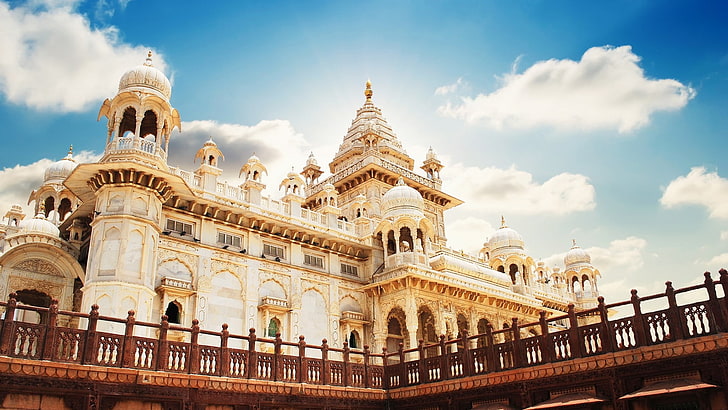OVERVIEW
A valiant sentinel in the desert, on the eastern fringe of the Thar Desert, has the distinction of neither being a part of the Thar Desert nor out of it. At best it is a doorway to the wonderland of sand dunes and shrubs, rocky, terrain and thorny trees. The home of the Rathores – the awesome princely state of Rajasthan, Marwar or Maroodesh, (land of the sand) was conquered by them after the fall of Delhi and Kannauj. In 1459 AD, Rao Jodha, chief of the Rathore clan of Rajputs, who claimed descent from Rama, the epic hero of the Ramayana, laid the foundation of Jodhpur. A high stone wall protects the wall-fortified city. The wall is nearly 10 km in length and has eight gates facing various directions. Within, stands an imposing fort on a low range of sandstone hills, about 125m above the surrounding plains. The city lies at the foot of the hills.
- MEHRANGARH FORT:
Crowning a perpendicular cliff, the fort was founded by Rao Jodha in 1459 AD when he shifted his capital from Mandore. It houses a palace intricately adorned with long carved panels and latticed windows exquisitely wrought from red sandstone. The apartments within the Moti Mahal (Peri Palace), Sileh Khana and Daulat Khana have their own magic with a rich, varied collection of palanquins, howdahs, royal cradles, furniture and an impressive armoury. The display of cannons on the ramparts near Chamunda temple is among the rarest in India. As you climb up, folk musicians revive the grandeur of a bygone era.
- UMMAID BHAWAN PALACE:
Built by Maharaja Ummaid Singh, and named after him, this exquisite palace is also known as Chittar Palace, because of the local chittar sandstone used. It is a splendid example of Indo-colonial art and the deco style of the 30s. A unique feature of this palace is that the hand chiselled sandstone blocks have been put together in a special system of interlocking; there is no mortar binding. A portion of the palace has been converted into a luxury hotel, and the remaining is open for visitors as an excellent museum, which houses model aeroplanes, antique weapons, clocks and bob watches, priceless crockery and hunting trophies. Both sections retain the ambience of royal splendour.
- MANDORE GARDENS:
Mandore was the capital of Marwar before the foundation of Jodhpur. Today its extensive gardens with high rock terraces make it a popular local attraction. The highlight of this place is the “Hall of Heroes” which houses sixteen gigantic figures chiselled out of one single rock. The statues are either of popular Hindu deities or famous folk deities. The royal cenotaphs or Devals of Jodhpur rulers on a high plinth crowned with soaring spires and ornate carving are amongst the other attractions of Mandore. The longest & finest of all cenotaphs are those built in the memory of Maharaja Jaswant Singh & Maharaja Ajit Singh. Mandore Garden is free, but inside the Garden, Govt. The museum is chargeable.
- NAVGRAH TEMPLE:
There is a Navgrah (Nine planets) temple which houses several statues of famous Hindu deities. It is situated on fort road. There is an interesting astrological museum based on the Hindu almanac.
- VEER DURGADAS RATHORE MEMORIAL PARK:
Durgadas Rathore (1638 to 1718 AD) is a famous personality in the annals of Marwar. He is credited with having single-handedly preserved the rule of the Rathore dynasty over Marwar (Jodhpur) after the death of Maharaja Jaswant Singh in the 17th century. A large statue, surrounded by a beautiful garden is located at a top of a hill known as Masuria Hill Park is worth visiting. One can have a bird’s eye view of the city from top of the hill.
- JASWANT THADA:
Built-in the memory of Maharaja Jaswant Singh II in 1899 AD, the imposing white marble memorial marks the site of a royal crematorium. It houses portraits of successive rulers. The four cenotaphs around here commemorate notable acts of bravery and generosity of the four Jaswant Thada successive rulers.
- ORIENTAL RESEARCH INSTITUTE:
An Art Gallery of Manuscripts & Miniatures is located at Rajasthan Oriental Research Institute situated on PWD road, Jodhpur. Run by Rajasthan Government, it was established with a view to collect, preserve, edit & publish ancient literature of Rajasthan and adjacent areas available in Sanskrit, Apbhrasma & Hindi – Rajasthani. A number of manuscripts, extending miniature in bountiful, which on the stylistic ground are termed as Pala, Western Indian. Rajput & Jammu-Kashmir schools and likewise some of the manuscripts lack miniatures but are treated rare on the ground of being based largely on palm birch-bank, paper, wood & cloth, while others on the ground of excelled calligraphy and text called Dvipath, Tripath & Panchpath.
- KAILANA LAKE:
It is situated on Jaisalmer road this small artificial lake is a charming picnic spot. It is like a canvas with a splash of romantic colours. The beauty will linger with you for a long time.
- MAHAMANDIR:
Literally ‘the great temple’ here sacred glory reigns in peaceful tranquillity. Situated on Mandore road the temple is an architectural splendour supported by 84 pillars and ornamented with detailed designs and figures depicting various postures of Yoga. The entire structure is marked by a unique and original style.
- OSIAN:
The ancient temples of Osian are sacred. Osian was a great trading centre between the 8th -12th centuries. Today it is a desert oasis with sixteen Brahmanical and Jain temples, beautifully sculpted and designed, most of which have stood the ravages of time. The largest of these are Sachchiya Mata temple and Mahavir Jain temple which are both functional. While in Osian watch out for lovely sunsets and camel rides in the desert.
